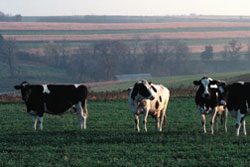USDA researchers using computers to simulate dairy cow living situations think keeping the animals outdoors more may be better for the environment.
 An Agricultural Research Service (ARS) team evaluated how different management systems on a typical 250-acre Pennsylvania dairy farm would affect the environment.
An Agricultural Research Service (ARS) team evaluated how different management systems on a typical 250-acre Pennsylvania dairy farm would affect the environment.
The study used the Integrated Farm System Model, a computer program that simulates the major biological and physical processes and interactions of a crop, beef or dairy farm. The scientists collected a range of field data on grazing systems, manure management and their effects on nutrient loss to the environment. Then they used their farm model, supported by the field data, to evaluate the environmental dynamics of four different dairy farms in all types of weather over 25 years.
The model generated estimates for ammonia emissions from manure, soil denitrification rates, nitrate leaching losses, soil erosion and phosphorus losses from field runoff. Estimates for emissions of carbon dioxide, methane, and nitrous oxide from both primary production and the secondary production of pesticides, fuels, electricity and other resources were also considered.
Compared to high confinement systems, keeping dairy cows outdoors all year lowered levels of ammonia emission by about 30 percent. The model results also indicated that the total emissions for the greenhouse gases methane, nitrous oxide and carbon dioxide were eight percent lower in a year-round outdoor production system than in a high-production confinement system.
